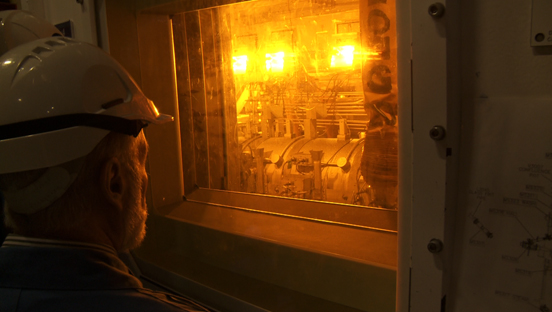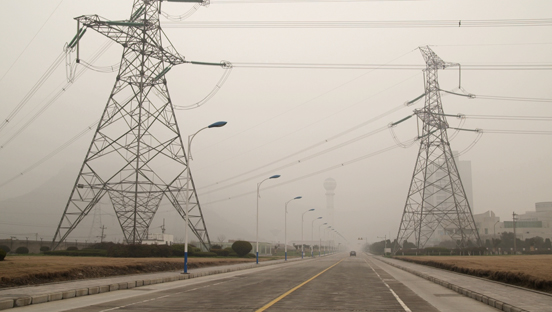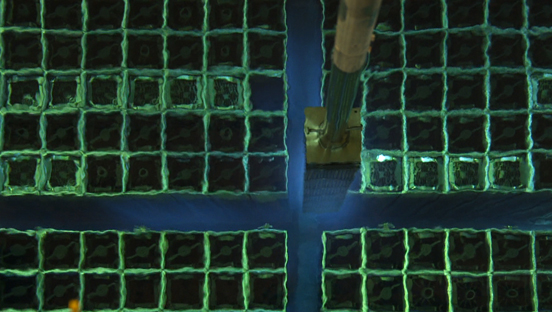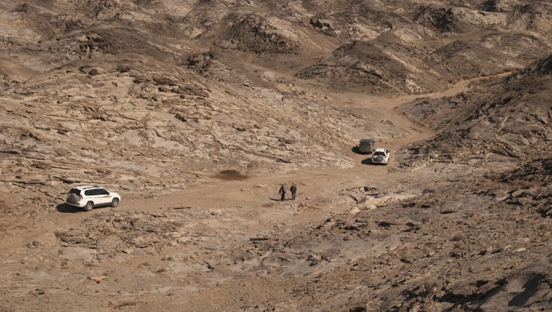1945
The first atomic bomb is dropped on Hiroshima. Charles McCombie is born in Aberdeen, Scotland; his father is a soldier in the Royal Air Force.
1953
Atoms for Peace: US President Dwight D. Eisenhower makes the case for commercial use of atomic energy at the UN General Assembly.
1956
Queen Elizabeth II inaugurates Calder Hall, the world’s first commercial nuclear power plant in Sellafield, Great Britain.
1957
The American National Academy of Sciences identifies and promotes “deep geological repositories” as a feasible solution for nuclear waste disposal.
1976
Planning begins in secret to develop a high-level nuclear waste repository on the Hanford Site in Washington State, USA.
1977
As a result of protests, high-level nuclear waste from the Sellafield plant has to be returned to the countries that sent it there for reprocessing, including Switzerland, Germany and Japan. Gorleben is designated as Germany’s repository site and also the site for a reprocessing plant. This decision is met with huge resistance from the German population. Switzerland turns down the offer from Jimmy Carter’s government to dispose of its high-level nuclear waste and spent fuel in the USA.
1978
The Swiss Cooperative for the Disposal of Radioactive Waste, Nagra, tasks Charles McCombie with developing Switzerland’s high-level nuclear waste disposal programme, known as “Projekt Gewähr”.
1979
Reactor disaster at the Three Mile Island nuclear power plant in Harrisburg, USA. 200,000 people are evacuated.
1985
Charles McCombie finalises "Projekt Gewähr", Switzerland’s first concept for a high-level nuclear waste repository. It aims to prove that safe disposal of high-level nuclear waste is possible – if this is not the case, Switzerland’s nuclear power plants would have to be shut down. Granite rock, the proposed material for the repository, turns out to be unsuitable. Nevertheless, the nuclear power plants remain in operation.
1986
Reactor disaster in Chernobyl, Ukraine. High-level nuclear substances are released into the atmosphere over a wide area, turning large swathes of land into uninhabitable zones. The real magnitude of the disaster is still under debate today. The International Atomic Energy Agency, IAEO, has recorded 58 related deaths; independent sources report over 300,000.
1987
The US repository project at the Hanford Site, WA, is terminated.
Yucca Mountain, Nevada, is designated as the site for the USA’s high-level nuclear waste repository. 2,000 scientists are tasked with proving the suitability of the mountain as a site.
1995
Charles McCombie is appointed to the American National Acadeym of Sciences. In Switzerland, he fails to realise the Swiss organisation Nagra’s plans to develop a low and intermediate-level nuclear waste repository due to resistance from the population in Wellenberg.
1996
Canada’s plans for a high-level repository are rejected.
1997
Plans for an intermediate-level repository in Sellafield, UK, are rejected.
1998
The coalition of the Social Democratic Party and The Greens in Germany orders a ten-year suspension of exploration work at the Gorleben site and decides to phase out nuclear energy.
Charles McCombie and partners start to develop the confidential Pangea project to construct the world’s first high-level nuclear waste repository in Western Australia, funded by Switzerland, Great Britain and Canada. Details of the plans are leaked and the project is terminated due to resistance from environmental campaigners.
1999
Charles McCombie is appointed to the international expert committee to salvage plans to build a high-level repository in Gorleben.
2002
Pangea is dissolved. Charles McCombie develops the first multi-national repository concept with the involvement of ten European countries.
2008
Switzerland designates three possible sites for a high-level nuclear waste repository. The proposed host rock is now clay. One of the sites is located on the doorstep of Charles McCombie’s house in Bözberg in the Canton of Aargau.
2010
Twenty-three years after construction began, US President Barack Obama terminates the Yucca Mountain Project for a high-level nuclear waste repository and the mountain is sealed off. Nevertheless, Obama plans to build new nuclear power plants. As an international expert, Charles McCombie is invited to join the US commission debating what should now happen to the high-level nuclear waste. The idea of an international repository in Australia is once again among the proposals.
The coalition government of the Christian Democrats and the Free Democrats in Germany orders resumption of exploration work in Gorleben in spite of resistance from the local population. It also decides to extend the life spans of the nuclear power plants.
2011
The Swedish nuclear waste disposal organisation SKB submits its application to construct a high-level repository in the community of Östhammar. The plans propose depositing the waste 500 metres below the earth in granite rock, next to Forsmark nuclear power plant on the Baltic Coast. It has the potential to become the world’s first high-level repository, but independent scientists question the safety analyses conducted by the nuclear fuel and waste management company SKB.
The Finnish high-level repository project Onkalo in the community of Eurajoki follows the same approach as in Sweden. If the Swedish application is not approved, this would also mean the end of the Finnish repository project. In Onkalo, exploration work is underway on granite rock in an access tunnel.
The nuclear disaster in Fukushima on 11 March shakes people’s faith in nuclear energy the world over. Numerous countries discontinue their nuclear energy programmes. This is not the case in the People’s Republic of China. Twenty-six nuclear power plants are under construction and building continues on a number of these construction sites. For example in Qinshan, by the Yellow Sea. Whether the high-level nuclear waste from China’s ambitious nuclear programme can be safely stored in the Gobi Desert for hundreds of thousands of years is yet to be seen.
2013
On 31 January two communities in Cumbria, Great Britain, vote against becoming voluntary sites for high-level nuclear waste repositories. Charles McCombie is the personal advisor to the director of the British nuclear waste disposal programme. Plans to build new British nuclear power plants carry on regardless.
The IAEO invites Charles McCombie to Vienna on several occasions. They welcome his commitment to developing multi-national and international high-level nuclear waste repositories. Not a single repository is in operation to date. It is unclear when, where or even whether the first site will open.






